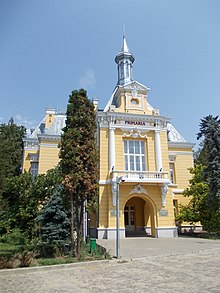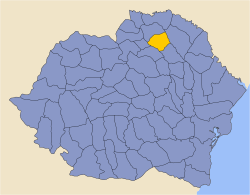Botoșani County
Botoșani County
Județul Botoșani | |
|---|---|
County | |
 Former Botoșani County Prefecture | |
 Location of Botoșani County in Romania | |
| Coordinates: 47°50′N 26°49′E / 47.84°N 26.82°E | |
| Country | |
| Development region1 | Nord-Est |
| Historic region | Moldavia |
| Capital city (Reședință de județ) | Botoșani |
| Government | |
| • Type | County Council |
| • President of the County Council | Doina Elena Federovici (PSD) |
| • Prefect2 | Sorin Cornilă |
| Area | |
• Total | 4,986 km2 (1,925 sq mi) |
| • Rank | 29th in Romania |
| Population (2021-12-01)[1] | |
• Total | 392,821 |
| • Rank | 22nd in Romania |
| • Density | 79/km2 (200/sq mi) |
| Time zone | UTC+2 (EET) |
| • Summer (DST) | UTC+3 (EEST) |
| Postal Code | 71wxyz3 |
| Area code | +40 x314 |
| Car Plates | BT5 |
| GDP | US$1.726 billion (2015) |
| GDP per capita | US$4,18 (2015) |
| Website | County Council County Prefecture |
| 1 as of 2007, the Prefect is not a politician, but a public functionary. He (or she) is not allowed to be a member of a political party, and is banned to have any political activity in the first six months after the resignation (or exclusion) from the public functionary corps 2w, x, y, and z are digits that indicate the city, the street, part of the street, or even the building of the address 3x is a digit indicating the operator: 2 for the former national operator, Romtelecom, and 3 for the other ground telephone networks 4used on both the plates of the vehicles that operate only in the county limits (like utility vehicles, ATVs, etc.), and the ones used outside the county | |
Botoșani County (Romanian pronunciation: [botoˈʃanʲ] ) is a county (județ) of Romania, in Western Moldavia (encompassing a few villages in neighbouring Suceava County from Bukovina to the west as well), with the county seat at Botoșani.
Demographics
[edit]As of 31 October 2011, it had a population of 412,626 and the population density was 83/km2.[2]
- Romanians – 94.1%
- Romani – 1%
- Ukrainians – 0.2%
- Lipovans – 0.1%
- Other ethnicities – 0.1%
- Unknown ethnicity – 4.6%
| Year | County population[3][4] |
|---|---|
| 1948 | 385,236 |
| 1956 | 428,050 |
| 1966 | 452,406 |
| 1977 | 451,217 |
| 1992 | 458,904 |
| 2002 | 452,834 |
| 2011 | 412,626 |
| 2021 | 392,821 |
Geography
[edit]- Botoșani County is situated between the rivers Siret and Prut, in the northeastern part of Romania, bordering Ukraine to the north and Moldova to the east. To the west and south it has borders with Suceava and Iași counties.
- It has a total area of 4,986 km2 (1,925 sq mi), comprising 2.1% of the Romanian territory.
- The relief is a high plain, between the valleys of the Siret and the Prut, and the latter's affluent, the Jijia River.
- It has a temperate climate, influenced by the eastern air masses of the continent.
Neighbours
[edit]- Republic of Moldova in the East – Edineț Raion.
- Suceava County in the West.
- Ukraine in the North – Chernivtsi Oblast.
- Iași County in the South.
Economy
[edit]
This is a predominantly agricultural county; the main industries are the textile industry, the food industry, the electrical components industry, and the glass and porcelain industry.
The Stânca–Costești Hydroelectric Power Station is one of the largest hydroelectric power plants in Romania. Work on it started in 1973, and it was completed in 1978, at the same time as the Stânca-Costești Dam. They are both situated on the Prut River, between Stânca in Botoșani County and Costești, Rîșcani.
Politics
[edit]The Botoșani County Council, renewed at the 2020 local elections, consists of 32 counsellors, with the following party composition:[5]
| Party | Seats | Current County Council | |||||||||||||||
|---|---|---|---|---|---|---|---|---|---|---|---|---|---|---|---|---|---|
| National Liberal Party (PNL) | 15 | ||||||||||||||||
| Social Democratic Party (PSD) | 15 | ||||||||||||||||
| PRO Romania (PRO) | 2 | ||||||||||||||||
Administrative divisions
[edit]

Botoșani County has 2 municipalities, 5 towns and 71 communes:
Municipalities
[edit]Towns
[edit]Communes
[edit]- Adășeni
- Albești
- Avrămeni
- Bălușeni
- Blândești
- Brăești
- Broscăuți
- Călărași
- Cândești
- Concești
- Copălău
- Cordăreni
- Corlăteni
- Corni
- Coșula
- Coțușca
- Cristești
- Cristinești
- Curtești
- Dersca
- Dângeni
- Dimăcheni
- Dobârceni
- Drăgușeni
- Durnești
- Frumușica
- George Enescu
- Gorbănești
- Havârna
- Hănești
- Hilișeu-Horia
- Hlipiceni
- Hudești
- Ibănești
- Leorda
- Lozna
- Lunca
- Manoleasa
- Mihai Eminescu
- Mihăileni
- Mihălășeni
- Mileanca
- Mitoc
- Nicșeni
- Păltiniș
- Pomârla
- Prăjeni
- Rădăuți-Prut
- Răchiți
- Răuseni
- Ripiceni
- Roma
- Românești
- Santa Mare
- Stăuceni
- Suharău
- Sulița
- Șendriceni
- Știubieni
- Todireni
- Trușești
- Tudora
- Ungureni
- Unțeni
- Văculești
- Viișoara
- Vârfu Câmpului
- Vlădeni
- Vlăsinești
- Vorniceni
- Vorona
Historical county
[edit]Județul Botoșani | |
|---|---|
County (Județ) | |
 The Botoșani County Prefecture building from the interwar period, currently the county museum. | |
 | |
| Country | |
| Historic region | Moldavia |
| Capital city (Reședință de județ) | Botoșani |
| Area | |
• Total | 3,077 km2 (1,188 sq mi) |
| Population (1930) | |
• Total | 218,258 |
| • Density | 71/km2 (180/sq mi) |
| Time zone | UTC+2 (EET) |
| • Summer (DST) | UTC+3 (EEST) |
During the years between the world wars, the county extended over different territory than currently. It was located in the northeastern part of Romania, in the northeast of the region or Moldavia. The county included the southern part of the present county and the northern part of the current Iași County. It was bordered to the west by the counties of Suceava and Baia, to the north by Dorohoi, to the east by Bălți, and to the south with Iași.
Administration
[edit]
In 1930, the county was divided into three districts (plăși):[6]
- Plasa Botoșani
- Plasa Jijia
- Plasa Siret
Administration was re-organized in 1938, comprising 4 districts:
- Plasa Bucecea (with 52 villages, headquartered in Târgu Bucecea)
- Plasa Răchiți (with 73 villages, headquartered in Botoșani)
- Plasa Sulița (with 49 villages, headquartered in Hârlău)
- Plasa Ștefănești (with 77 villages, headquartered in Ștefănești)
Population
[edit]According to the 1930 census data, the county population was 218,258 inhabitants, ethnically, 88.8% were Romanians, 9.0% were Jews, as well as other minorities. From the religious point of view, 89.4% were Eastern Orthodox, 9.2% Jewish, 0.7% Roman Catholic, as well as other minorities.
Urban population
[edit]In 1930, the county's urban population was 50,320 inhabitants, comprising ethnically 64.9% Romanians, 31.3% Jews, 0.9% Germans, as well as other minorities. From the religious point of view, the urban population was composed of Eastern Orthodox (64.5%), Jewish (32.3%), Roman Catholic (2.1%), as well as other minorities.
Notable people
[edit]Natives of the county include:
- Grigore Antipa (1866–1944), naturalist
- Teoctist Arăpașu (1915–2007), patriarch
- Gheorghe Avramescu (1884–1945), general
- Emil Bobu (1927–2014), politician
- Demostene Botez (1893–1973), poet
- Dimitrie Brândză (1846–1895), botanist
- Mihai Eminescu (1850–1889), poet
- George Enescu (1881–1955), composer
- Nicolae Iorga (1871–1940), historian and politician
- Ștefan Luchian (1868–1916), painter
- Gheorghe Moroșanu (b. 1950), mathematician
- Dimitrie Pompeiu (1873–1954), mathematician
- Alexandru Zub (b. 1934), historian
See also
[edit]Notes
[edit]References
[edit]- ^ "Populaţia rezidentă după grupa de vârstă, pe județe și municipii, orașe, comune, la 1 decembrie 2021" (XLS). National Institute of Statistics.
- ^ "Tab8. Populația stabilă după etnie – județe, municipii, orașe, comune". Archived from the original on 18 January 2016. Retrieved 31 August 2013.
- ^ "Tab1. Populația la recensămintele din anii 1948, 1956, 1966, 1977, 1992, 2002 și 2011 – categorii de localități și județe". Archived from the original on 10 June 2017. Retrieved 31 August 2013.
- ^ "Populaţia României pe localitati la 1 ianuarie 2016" (in Romanian). INSSE. 6 June 2016. Archived from the original on 27 October 2017. Retrieved 27 October 2017.
- ^ "Rezultatele finale ale alegerilor locale din 2020" (Json) (in Romanian). Autoritatea Electorală Permanentă. Retrieved 2 November 2020.
- ^ Portretul României Interbelice – Județul Botoșani
External links
[edit]- Botoșani County
- Counties of Romania
- 1879 establishments in Romania
- 1938 disestablishments in Romania
- States and territories disestablished in 1938
- States and territories established in 1879
- 1940 establishments in Romania
- 1950 disestablishments in Romania
- States and territories established in 1940
- States and territories disestablished in 1950





